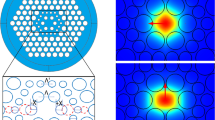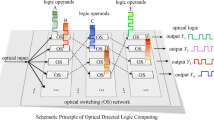Abstract
Due to its many advantages, orthogonal frequency division multiplexing (OFDM) is frequently utilised in optical wireless systems to achieve rapid data transmission. Hybrid asymmetrically clipped optical OFDM (HACO-OFDM) is a widely utilised approach in OFDM-based visible light communication (VLC) systems because it allows for high-rate burst transmission while maintaining reliability in a multi-path fading environment. Meanwhile, the congenital nonlinear characteristic of LEDs is a critical hindrance in VLC OFDM systems due to the high peak-to-average power ratio (PAPR) of OFDM signals. The high PAPR necessitates a large input back-off power to operate LEDs in the linear zone, lowering the BER of OFDM-based optical devices. In order to reduce PAPR and ameliorate non-linearity in the HACO-OFDM system, this work offers a hybrid precoder with \(\upmu\)-law compander approach. The auto-correlation association of modulated data symbols is suppressed by pre-processing in the frequency domain using a preset precoder matrix (PM), resulting in a low PAPR score. PAPR is further reduced by compressing the precoded signal in the time domain with the \(\upmu\)-law compressor. The PAPR of the proposed design is just 5.1 dB. It also reduces the non-uniform SNR spread among data symbols and mandates a low SNR for a 10\(^{-5}\) reference bit error rate (BER). Furthermore, with a reference BER of 10\(^{-3}\), the hybrid approach reduces the optical bit energy required for high-speed data transmission. The metric used to calculate the system’s non-linearity is the percentage error vector magnitude (EVM %). For 0 dB input back-off (IBO), the hybrid technique has an EVM of 5.59%, compared to 30% for a traditional HACO system. The reduction in LED nonlinearity reduces in-band and out-of-band distortion, allowing high-data-rate services to be supported.









Similar content being viewed by others
Data Availability
Not applicable
References
Ghassemlooy, Z., Arnon, S., Uysal, M., Xu, Z., & Cheng, J. (2015). Emerging optical wireless communications-advances and challenges. IEEE Journal on Selected Areas in Communications, 33(9), 1738–1749.
Chowdhury, M. Z., Hossan, M. T., Islam, A., & Jang, Y. M. (2018). A comparative survey of optical wireless technologies: Architectures and applications. IEEE Access, 6, 9819–9840.
Chi, N., Haas, H., Kavehrad, M., Little, T. D. C., & Huang, X. (2015). Visible light communications: Demand factors, benefits and opportunities [Guest Editorial]. IEEE Wireless Communications, 22(2), 5–7.
Yang, F., Gao, J., & Liu, S. (2016). Novel visible light communication approach based on hybrid OOK and ACO-OFDM. IEEE Photonics Technology Letters, 28, 1–1, 01.
Yang, F., & Gao, J. (2017). Dimming control scheme with high power and spectrum efficiency for visible light communications. IEEE Photonics Journal, 9(1), 1–12.
Gancarz, J., Elgala, H., & Little, T. D. C. (2013). Impact of lighting requirements on VLC systems. IEEE Communications Magazine, 51(12), 34–41.
Zhang, T., Zou, Y., Sun, J., & Qiao, S. (2019). Design of PAM-DMT-based hybrid optical OFDM for visible light communications. IEEE Wireless Communications Letters, 8(1), 265–268.
Fernando, N., Hong, Y., & Viterbo, E. (2012). Flip-OFDM for unipolar communication systems. IEEE Transactions on Communications, 60(12), 3726–3733.
Sanya, M. F., Djogbe, L., Vianou, A., & Aupetit-Berthelemot, C. (2015). DC-Biased optical OFDM for IM/DD passive optical network systems. Journal of Optical Communications and Networking, 7(4), 205–214.
Zhou, J., Qiao, Y., Cai, Z., & Ji, Y. (2015). Asymmetrically clipped optical fast OFDM based on discrete cosine transform for IM/DD systems. Journal of Lightwave Technology, 33(9), 1920–1927.
Wang, Q., Qian, C., Guo, X., & Wang, Z. (2015). Layered ACO-OFDM for intensity-modulated direct-detection optical wireless transmission. Optics Express, 23(9), 12 382-12 393.
Dissanayake, S., Armstrong, J., & Panta, K. (2011). A novel technique to simultaneously transmit ACO-OFDM and DCO-OFDM in IM/DD systems. In 2011 IEEE Globecom Workshops, X. Zhang, Ed. United States of America: IEEE, Institute of Electrical and Electronics Engineers, pp. 808 – 812, iEEE GLOBECOM Workshop on Optical Wireless Communications 2011, OWC 2011 ; Conference date: 05-12-2011 Through 05-12-2011.
Islim, M. S., & Haas, H. (2016). Augmenting the spectral efficiency of enhanced PAM-DMT-based optical wireless communications. Optics Express, 24(11), 11 932-11 949.
Tsonev, D., Videv, S., & Haas, H. (2015). Unlocking spectral efficiency in intensity modulation and direct detection systems. IEEE Journal on Selected Areas in Communications, 33(9), 1758–1770.
Ranjha, B., & Kavehrad, M. (2014). Hybrid asymmetrically clipped OFDM-based IM/DD optical wireless system. IEEE/OSA Journal of Optical Communications and Networking, 6(4), 387–396.
Dardari, D., Tralli, V., & Vaccari, A. (2000). A theoretical characterization of nonlinear distortion effects in OFDM systems. IEEE Transactions on Communications, 48(10), 1755–1764.
Li, Xiaodong, & Cimini, L. J. (1998). Effects of clipping and filtering on the performance of OFDM. IEEE Communications Letters, 2(5), 131–133.
Sun, Y., Yang, F., & Gao, J. (2017). Comparison of hybrid optical modulation schemes for visible light communication. IEEE Photonics Journal, 9(3), 1–13.
Hu, W. W. (2020). Design of cyclic shifted PAM-DMT signals in HACO-OFDM visible light communication. IEEE Communications Letters, 24(12), 2834–2838.
Binita, A., & Hema, P. P. (2019). Reduction of PAPR in HACO OFDM Signals using PTS Schemes. In 2019 2nd International conference on intelligent computing, instrumentation and control technologies (ICICICT), vol. 1, pp. 1516–1521.
Liu, H., Jiang, Y., Zhu, X., & Wang, T. (2019). Low-Complexity and Robust PAPR Reduction and LED Nonlinearity Mitigation for UACO-OFDM LiFi Systems. In ICC 2019 - 2019 IEEE International conference on communications (ICC), pp. 1–6.
Ren, J., Wang, T., Wang, C., & Li, D. (2020). Low-PAPR Superimposed Layered ACO-OFDM for VLC Systems. In 2020 12th International conference on communication software and networks (ICCSN), pp. 178–181.
Sharan, N., Ghorai, S. K., & Kumar, A. (2019). Peak-to-Average Power Ratio (PAPR) reduction using combination of precoding and companding techniques for VLC OFDM systems. In 2019 TEQIP III Sponsored International conference on microwave integrated circuits, photonics and wireless networks (IMICPW), pp. 149–153.
Sharan, N., & Ghorai, S. (2020). PAPR reduction and non-linearity alleviation using hybrid of precoding and companding in a visible light communication VLC system. Optical and Quantum Electronics, 52, 1–4.
Sharan, N., & Ghorai, S. K. Hybrid scheme of precoder with \(\upmu\)-law compander for PAPR reduction and nonlinearity improvement in ADO-OFDM system. International Journal of Communication Systems,34(16), e4961. [Online]. Available: https://onlinelibrary.wiley.com/doi/abs/10.1002/dac.4961.
Sharan, N., Ghorai, S. K., & Kumar, A. (2021). Papr reduction using blend of precoder and \(\upmu\)-law compander in HACO system. In 2021 IEEE 2nd International Conference on Applied Electromagnetics, Signal Processing, and Communication (AESPC), pp. 1–5.
Elgala, H., Mesleh, R., & Haas, H. (2009). Non-linearity effects predistortion in optical OFDM wireless transmission using leds. International Journal of Ultra Wideband Communications and Systems, 1, 10.
Slimane, S. B. (2007). Reducing the peak-to-average power ratio of OFDM signals through precoding. IEEE Transactions on Vehicular Technology, 56(2), 686–695.
Liu, Z., Xin, Y., & Giannakis, G. (2003). Linear constellation precoding for OFDM with maximum multipath diversity and coding gains. IEEE Transactions on Communications, 51(3), 416–427.
Kaiser, S. (1995). On the performance of different detection techniques for OFDM-CDMA in fading channels. In Proceedings of GLOBECOM ’95, vol. 3, pp. 2059–2063.
Slimane, S. (2000). Partial equalization of multi-carrier CDMA in frequency selective fading channels. In 2000 IEEE International Conference on Communications. ICC 2000. Global Convergence Through Communications Conference Record, vol. 1, pp. 26–30.
Fazel, K. (1993). Performance of cdma/ofdm for mobile communication system. In Proceedings of 2nd IEEE International Conference on Universal Personal Communications, vol. 2, pp. 975–979.
Jiang, T., Tang, M., Lin, R., Feng, Z., Chen, X., Deng, L., Fu, S., Li, X., Liu, W., & Liu, D. (2018). Investigation of DC-biased optical OFDM With precoding matrix for visible light communications: theory, simulations, and experiments, year. IEEE Photonics Journal, 10(5), 1–16.
Gharaibeh, K., Gard, K., & Steer, M. (2004). Accurate estimation of digital communication system metrics - SNR, EVM and \(\rho\) in a nonlinear amplifier environment. In 64th ARFTG Microwave Measurements Conference, Fall 2004., pp. 41–44.
Funding
The work was supported by Birla Institute of Technology (BIT), Mesra under the Institute Research Fellowship (IRF) scheme - GO/Estb/Extn-Institute-F/Ph.D/2020–21/4231.
Author information
Authors and Affiliations
Contributions
All the authors have accepted responsibility for the entire content of this submitted manuscript and approved submission.
Corresponding author
Ethics declarations
Conflict of interest
The authors declare that they have no conflict of interest.
Additional information
Publisher's Note
Springer Nature remains neutral with regard to jurisdictional claims in published maps and institutional affiliations.
Rights and permissions
Springer Nature or its licensor (e.g. a society or other partner) holds exclusive rights to this article under a publishing agreement with the author(s) or other rightsholder(s); author self-archiving of the accepted manuscript version of this article is solely governed by the terms of such publishing agreement and applicable law.
About this article
Cite this article
Sharan, N., Ghorai, S.K. & Kumar, A. Alleviating LED Nonlinearity in a HACO System Using a Blend of Precoder and a \(\upmu\)-Law Compander. Wireless Pers Commun 131, 1149–1165 (2023). https://doi.org/10.1007/s11277-023-10474-5
Accepted:
Published:
Issue Date:
DOI: https://doi.org/10.1007/s11277-023-10474-5




